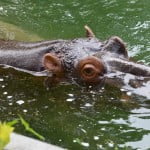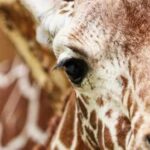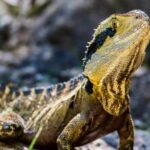Red Pandas: Endangered and Unique
Samantha Allworthy studied for a degree in animal management before getting into zookeeping. She has been working with red pandas for seven years and volunteers for the Red Panda Network as a science expert. Samantha travelled to Nepal in 2017 to track and observe red pandas in their wild habitat and see first-hand the threats they face. In our latest blog for today’s International Red Panda Day, Samantha shares her passion for these animals’ unique and interesting nature.
Red pandas have become a popular species exhibited in zoos and safari parks around the world. Well-known for spending their days snoozing in the trees, these charismatic creatures tick all the boxes of being cute, fluffy, and adorable to look at. A rise in popularity due in part to social media has increased interest in the species over recent years. But is there more to them and their lifestyles than meets the eye?
One thing I have always found very interesting about red pandas is their uniqueness. The only living member of the family aliurdae, they are unlike any other species still alive today. A common misconception is a relationship with the giant panda, but apart from sharing a name and a fondness for bamboo they are not considered to be closely related. Recently, new genetic research has regrouped red pandas, suggesting that instead of two subspecies there are two separate species, one of which is found in China and the other throughout the Himalayas. Living in parts of China and the foothills of the Himalayas at an elevation of 2,500 – 5,000 metres, natural red panda habitat is temperate cloud forest, and they spend most of their life high up in the trees, occasionally coming down to ground to visit a water source or to change tree.
Despite being classified as a carnivore due to their digestive system, the wild diet of a red panda is made up of 98 per cent bamboo.
This can see them eating up to 20,000 leaves a day, along with occasional seasonal fruits and protein items such as eggs or small birds. Their bamboo heavy diet is one reason that red pandas are well-known for being lazy, as bamboo’s high fibre, low nutrient concentration means they have to eat a large amount to get all the energy they need, so they will conserve energy by lazing around!
Solitary by nature, red pandas spend most of their life on their own, coming together only to breed, with males playing no part in bringing up any offspring. A female is only able to conceive for one short period each year and if successful will give birth to between one and four cubs. Single or twin births are most common, and the cubs are completely reliant on their mother. They will start leaving the nest at three months old and wean from her at six months, but they may stay with her until they are 10 months old, before dispersing to start their own lives. Young panda cubs are helpless and extremely susceptible to predation from a variety of species, particularly yellow-throated martens, and large birds of prey, and due to this vulnerability, it is thought only one in five red panda cubs born in the wild ever make it to adulthood.
All knowledge on the wild behaviour of the animals we look after in captivity helps us do better for them every day.
Although a commonly kept species in captivity, red pandas are not thoroughly researched in the wild, in part due to their remote location, the difficulty in tracking them and the lack of wild individuals. Listed as endangered on the IUCN Red List, there are thought to be less than 10,000 individuals in the wild, with recent estimates putting the figure perhaps as few as 2,500. The main threats to their survival are habitat loss and deforestation but sadly they are also trafficked for trade in fur, body parts and more recently the illegal pet trade. As with many endangered species the captive population is becoming more important than ever, with populations carefully managed in international breeding programs to keep a healthy genetically diverse group of animals.
Animal keepers manage the day-to-day care and welfare of red panda individuals within the captive population, Keeper considerations include being able to provide the specialist bamboo diet that these animals need to thrive. Many wildlife facilities have onsite bamboo plantations that help cater for the vast quantities required and there are also specially produced diets available. But giving a more natural diet allows for the expression of natural behaviours along with a more natural activity budget; red pandas spend a large amount of time foraging and consuming bamboo, so being able to replicate this in captivity is imperative for good welfare. As with any species, enclosure design should take inspiration from the species’ native habitat and in this case the dense and complex forest where these animals spend their time. Although this can make viewing trickier for visitors, it is vital to give this opportunity for climbing and hiding so this elusive species can express natural behaviour.
Red pandas are often calm and easy for keepers to work with and do well in positive reinforcement training programs.
Positive reinforcement can aid in preventative healthcare, earlier recognition of ailments and simple behaviours like weighing, being moved in a travel crate and a basic healthcheck. The use of positive reinforcement can really improve welfare by reducing or eliminating the need for routine anaesthetics or catch and restraint, that can pose a risk of injury and stress to animal and keeper.
Working with an endangered species like the red panda in a captive setting is an immense privilege, giving keepers the chance to play a small role in the conservation of a unique animal. And the more we can learn about their natural habitat, diet and even their history as a species, the better decisions we can make daily, to offer them the highest possible standard of welfare. Read more about red panda care in captivity in Wild Welfare’s Care for Us Guide
The views, opinions and positions expressed by guest bloggers are theirs alone, and do not necessarily reflect the opinions of Wild Welfare or any employee thereof. Wild Welfare is not responsible for the accuracy of any of the information supplied by the guest bloggers. We accept no liability for any errors, omissions or representations. The copyright of this content belongs to the author and any liability with regards to infringement of intellectual property rights remains with them.
Image © Pelican from Tokyo, Japan [CC BY-SA 2.0] via Wikimedia Commons

![A red panda climbing a tree in its zoo enclosure, Image © Pelican from Tokyo, Japan [CC BY-SA 2.0] via Wikimedia Commons](https://wildwelfare.org/wp-content/uploads/2018/08/red-panda-Japanese-zoo-e1534953982249.jpg)



